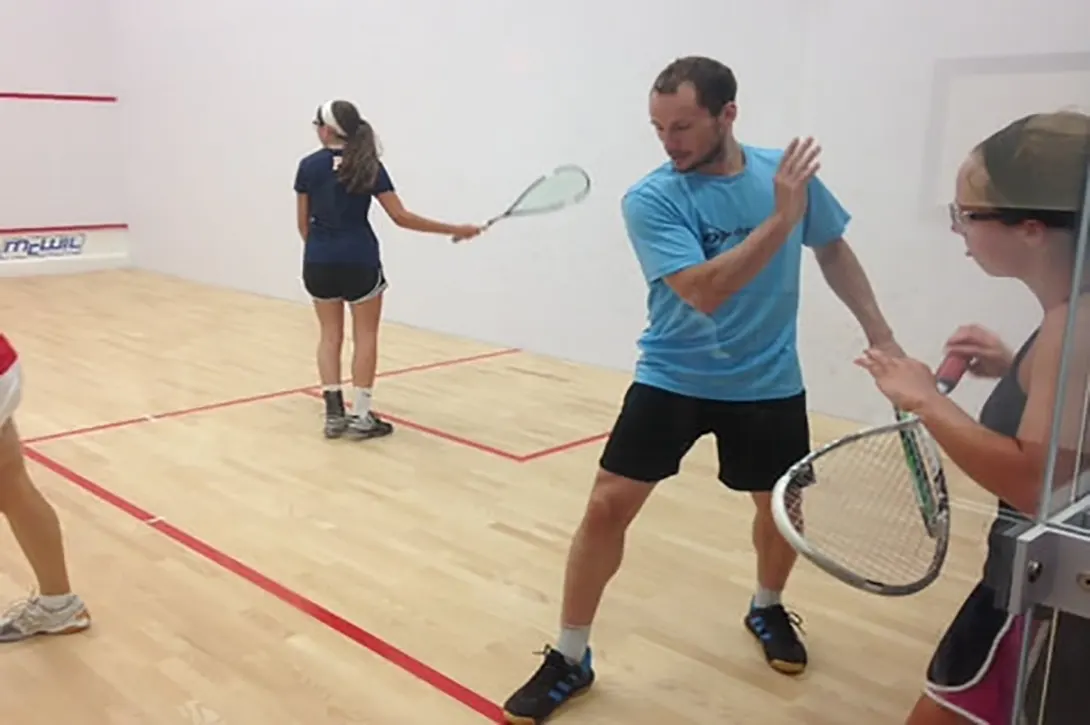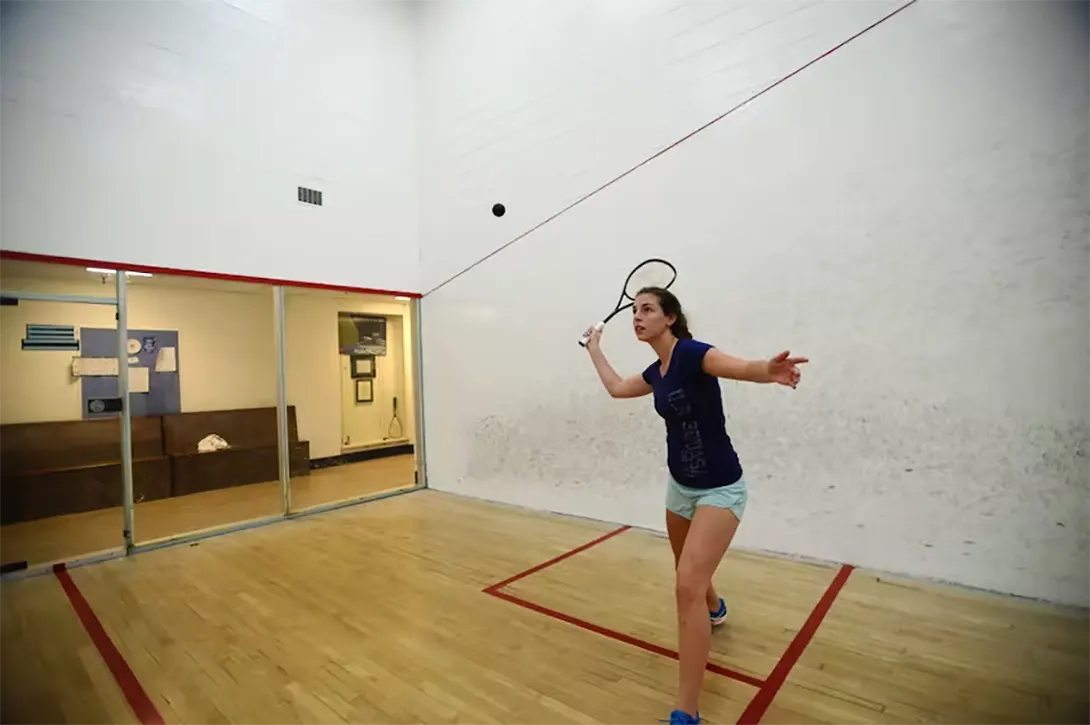24 November 2022 / 5-Min Read / Translate
I’m not a huge fan of the blue dot ball. I feel it’s too bouncy. Now, bouncy *is* good, especially when you first start playing squash, but the blue dot just doesn’t feel right. A room temperature red dot bounces more or less the same as a very warm double yellow, which means that new players can become accustomed to similar bounce profiles right from the beginning.
At this point it’s worth noting that Dunlop’s blue and red dot balls are larger than the yellow and double yellow. Other brand’s balls are not. At least not in general. Again, given the choice, I would use a standard size red dot. I’m not against making the game easier for new players, especially children, but in this case i don’t feel the larger balls provide any real benefit and the fractured market may only confuse players.
As a coach I always ensure that whatever ball I am using with a pupil is the ball that they can also use alone or with their other playing partners. I feel there’s little point in using a yellow dot on court with me, but then not being able to use it when they practice alone. I don’t follow that rule 100%, because they might be an overlap of time when pupils are on the cusp of switching.
So, assuming you are playing with a red dot, when is the best time to switch to a yellow, or from yellow to double yellow?
The simple answer is to try the new ball and see how successful you are. Yes, that’s an obvious thing to say, but there’s isn’t really an agreed test or hitting pattern that can objectively decide when you should switch balls. If you can keep the ball going and it increases in temperature then that’s a clear sign you should probably use that ball.
The easiest way to know if the ball increases in temperature is to look at the bounce: has it become a little bigger? The next way is to hold the ball in your hand. If the ball feels warm or hot to the touch – well done, you and your partner have hit it consistently cleanly to increase the temperature. The answer is: in your hand!

Grégory Gaultier shows a pupil how to prepare for a backhand swing
A red dot can be hit, practiced with and played with, with little to no increase in temperature. That’s not to say that beginners will be able to hit it cleanly each time, but nothing special needs to be done to the ball unless the court is extremely cold. As beginners get a little better, the number of clean hits become more consistent, with fewer mishits. Rallies become longer and the amount of court covered greater. There should also be an increase in power, although that should not be the total focus of the player.
A lot depends on the standard of both players. If one player is able to keep the ball going, but the other player keeps making mistakes or mishitting the ball, then the ball has less opportunity to get hot. That’s why a coach and a new player will always have more success, because the coach will keep the ball in play and the new player will be the deciding factor. It’s the same with two players; the lower level player is the deciding factor. If they can’t keep a rally going, then the ball can’t get hot.
As far as standard is concerned, it’s my experience that the time to think about switching from red to yellow is when you can easily get the ball out of the back corners as long as the bounce isn’t too low. if the ball hits the back wall at about a racket length’s height off the floor and comes far enough off the back wall to have a swing, and you can hit that shot consistently, then that’s the time I would try a single yellow dot.
When I first started coaching, I was off the opinion that if players couldn’t get a single yellow hot on their own, then they shouldn’t use it. over the years, I have softened that opinion. It’s been my experience that when given a hot single yellow dot and two players of similar standard, they *are* able to keep it hot or at least it takes a longer time to become cooler.
In many ways, this artificially heated ball is an intermediate step between red dot and yellow dot, even though it uses a yellow dot. Give a player a room temperature yellow dot and ask them to get it hot and they struggle. Give them a hot yellow dot and it will bounce enough for them to keep hitting it cleanly, thereby keep it hot.
Sometimes simply holding the ball in your non-playing hand for 5 minutes is enough to raise the temperature to make it viable. Other times, you might need to put in on a radiator. I have even used those hand-warmers that you snap to make the gel become hot. Wrap the ball in one of those and a towel and in 5 minutes it’s perfect!
The same concept goes for a double yellow dot. As players get better though switching from a single yellow to double yellow should in theory be a little easier as players have passed the inconsistent stage.

How cleanly you hit the ball on serves, both forehand and backhand, is also a good test for your ability
Okay, so stage one might be artificially heating the double yellow dot and trying with that. If that’s easy, then start with a room temperature ball and see if you can get it hot.
As with the red to yellow, my general criteria is the back corners. I have tried and even list solo hitting tests in my Use The Right Ball guide, but ultimately it comes back to what I said about *both* players’ standards being important. In fact, for me it’s the same test. Can you get the ball out of the back corner consistently? If you can, then it’s time to try the double yellow. As I said, start with the heated ball and see if you can keep it hot.
Just a quick word of caution about getting a ball hot. It’s tempting to want to hit the ball as hard as possible. You see the pros smack the ball and almost within 5 shots it’s ready. YOU ARE NOT A PRO! Hit the ball cleanly and consistently and it will get hot. Obviously don’t hit very soft shots, but don’t put all your effort into trying to get the ball as hot as possible in as few shots as possible. Hit the ball at 80% your maximum and that’s enough.

How cleanly you hit the ball on serves, both forehand and backhand, is also a good test for your ability
You might have started reading this article in the hope I was going to give you one thing to do and it would decide which ball to use. Sorry, but it’s rarely that simple. There’s too many factors involved, not least the combined ability of both players. My back corner test seems to be a useful real-world test, but if using the slower ball still allows you to have fun rallies and gives you plenty of exercise then that’s all that really matters.
One final piece of advice: don’t rush the switch to slower balls. You might feel that playing with a single yellow or double yellow proves you have improved, but ultimately enjoyment is more important than improvement. Every now and again, try a slower ball and compare to the previous game: was it as much fun? If not, wait a little longer.